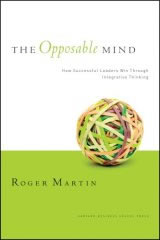


June 2011
Special Event: If you like 99-Word Stories, please plan to join a webinar I'll be giving on June 3. It's free and will be a great opportunity to learn how to use very short stories for training and coaching. Click this link for more information and to register:
http://www5.traininggamesnetwork.com/welcome/99Words-June3
Hope to see you then! -- Brian
An Invitation: Join nationally-known leaders of innovative learning techniques. Become a presenter at the North American Simulation and Gaming Association (NASAGA) Conference!
Your Feedback: The Downside of Lectures
In this Issue:
|
Say
It Quick |
Discoveries bits of serendipity to inspire and motivate |
Ideas fuel for your own continuous learning |
Activities tips and tricks you can try today |
| Turn Right to Go Left | The Opposable Mind | An Integration of Extermes | Flip a Coin |
The most difficult decisions to make are those between opposites. The differences are stark, yet both have a downside. Fortunately, there is a way to integrate both extremes into an original solution. In just 99 words, this story offers a starting point.
Turn
Right to Go Left
Busy intersections are few in rural Vermont, but during tourist season you
can wait a long time to make a left turn onto a crowded thoroughfare. Recently
I just could not find a break in the traffic flowing east that coincided with
the traffic flowing west.
Then an idea! Switching signals, I turned right into the flow. Less than a tenth of a mile later, I turned left into a parking lot and took another right joining the traffic in the direction of my original intent.
Got something difficult to do? Try the opposite!
 The
Opposable Mind
The
Opposable Mind
Winning Through Integrative Thinking
"Either you love it or you hate it, there's no in between." Whether "It" refers to people, politics, or pop music, popular wisdom says it's impossible to hold two opposite points of view in your mind at the same time. Yet being able to embrace diametrically opposed ideas and see the merits of each may be the best way to solve intractable problems or discover creative alternatives to difficult situations. That's the claim Roger Martin makes in his book, The Opposable Mind.
Martin's premise is that the best solutions come from integrative thinking, which is the ability to face the tension of opposable ideas and, instead of choosing one over the other, create a new idea that contains elements of both but is better than either (page 15). Martin conducted extensive interviews of numerous business leaders, scientists, and entrepreneurs to discover how they were able to bridge the gap between opposing views.
Integrative thinkers, Martin found, differ from conventional thinkers in four ways: a.) they considered more features of a problem; b.) they considered multidirectional and nonlinear causality; c.) they visualized the whole while working on individual parts; and d.) they searched for a creative resolution of tensions.
Throughout the book, Martin shares detailed accounts of how people redefined businesses such as the hotel industry, higher education, cable television, computer software, and finance. Entrepreneurs found novel solutions in rapidly changing fields where most everyone else saw only two choices.
But Martin does more than tell stories about successful people. He teaches readers how to exercise and build their own opposable minds. The ability to invent unlikely solutions when others see only two options begins with what Martin calls stance or the mental model through which you view the world. Integrative thinkers have a stance which recognizes that every point of view gives just a partial glimpse of reality. Therefore, every point of view has some validity.
Stance then guides the choice of tools that integrative thinkers use. Tools can be formal theories, established processes, or even rules of thumb. By their stance, integrative thinkers choose the right tool to test a particular point of view. This, then, determines the experiences the integrative thinker will have. And those experiences in turn will inform the person's stance.
Martin spends about half the book outlining how to fine tune your stance, tools, and experiences. He describes specific attitudes, skills, and techniques to help readers begin thinking more broadly and creatively. Martin compares integrative thinking to the human hand. With its opposable thumb, your hand creates tension between all your fingers enabling you to grasp and manipulate objects. That same manipulative ability is available to your mind as well, enabling you to hold the tension between opposing views long enough to discover a third unexpected possibility.
The Opposable Mind by Roger Martin, Harvard Business Press, 2009, ISBN: 978-1-4221-3977-6
 An
Integration of Extremes
An
Integration of Extremes
North Americans seem to thrive on dualities and extremes. And there's no better
example of this than our news media. Stories are positioned in black and white
terms that highlight the differences between views. Of course, it's good to
hear both sides of an issue but we also rarely hear a third or fourth perspective.
Depending on the news story or the reporting source, some stories are exaggerated
pitting "good" against "evil."
When this happens, the news becomes no more than entertainment; a drama without middle ground. When there are only two possible options to consider, someone has to be the winner. Who will it be? Stay tuned for details at 11:00!
An article in the January 31, 2011 issue of the Christian Science Monitor titled "Why Most Americans Are Both Liberal and Conservative," offers an example of how nuanced opinions are overlooked by the news media. The article sites polling data that shows most Americans espouse a mixture of conservative and liberal roles for government. The majority of Americans prefer a smaller federal government with local control, a conservative stance. But at the same time, they also prefer broad social programs like Social Security that promote equal opportunities, a liberal point of view. Interestingly, the article points out that this "in between" preference of most Americans has been true throughout much of our history.
 This
fascination with extremes hampers the ability to use our full creative potential
because the most fertile ground for innovation is where unusual ideas overlap.
In the book "Where Good Ideas Come From" (Reviewed in the January
2011 Firefly News Flash), author Steven Johnson writes about liquid networks;
the fluid exchange of ideas when different viewpoints intersect. He argues
that creative concepts are spawned when unlikely notions converge.
This
fascination with extremes hampers the ability to use our full creative potential
because the most fertile ground for innovation is where unusual ideas overlap.
In the book "Where Good Ideas Come From" (Reviewed in the January
2011 Firefly News Flash), author Steven Johnson writes about liquid networks;
the fluid exchange of ideas when different viewpoints intersect. He argues
that creative concepts are spawned when unlikely notions converge.
Unfortunately, we are won't experience that convergence if we only see issues as opposites on distant ends of a polarity. However, when we are able to bring those extremes close enough together so they can overlap, new and unexpected possibilities might emerge. As the 99-Word Story this month suggests, trying the opposite point of view for a while might set us off in a better direction.
If this works for you, please so other readers can see that new direction you've chosen!
Flip
a Coin
Suppose you are playing your favorite board game with friends. When it comes
to your turn, you reach for the dice but your friend hands you a coin instead.
She insists that you flip it rather than rolling the dice for your turn. Heads
you move forward one space, tails you don't. How long would you play under
those conditions? How much fun would it be?
Clearly you'd have more chances to move forward and a lot more fun with a six-sided die. Play long enough by the toss of a coin and you might even opt for a die with ten sides - or more! The more options you give yourself beyond heads or tails, the more fun you'll have. So why not have fun with the whole concept of opposites, dualities, polarities, and extremes? Let's make a game of identifying multiple options!
To play this game, look for opportunities to catch yourself thinking only of the extremes. When you find them, give yourself one point then try to define a more complete continuum of possibilities in between the polls. Remind yourself that neither of the dualities is a fully accurate view of the world. Award yourself additional points when you identify each new viewpoint.
Keep this game in play anytime: at work when the stakes are high, at home when the emotions are hot, and whenever you feel pressured to make a decision. Be ready to ask yourself, "Is what I'm seeing the most complete picture of reality or is there more to see?"
 Of
course, it won't be easy to recognize these situations when they arise. So,
to help you keep looking for multiple options, here's my tip. Slip a pair
of dice in your pocket for the next week as a reminder to downplay your dualistic
tendencies. Let them mingle with the coins there and consider the contrast
between flipping a coin and rolling dice. Hold them in your hand when you
walk into a potentially difficult meeting or as you go to pick up your partner
or kids. Pull them out at the end of the day and award yourself another point
for the effort you made to seek out multiple viewpoints.
Of
course, it won't be easy to recognize these situations when they arise. So,
to help you keep looking for multiple options, here's my tip. Slip a pair
of dice in your pocket for the next week as a reminder to downplay your dualistic
tendencies. Let them mingle with the coins there and consider the contrast
between flipping a coin and rolling dice. Hold them in your hand when you
walk into a potentially difficult meeting or as you go to pick up your partner
or kids. Pull them out at the end of the day and award yourself another point
for the effort you made to seek out multiple viewpoints.
If you take up the challenge to play this game, please your high score and how you achieved it. Good luck and have fun!
Here are a couple responses to the Discovery in May of Prezi, the zooming presentation tool:
Great newsletter. In about 2 minutes I got the message and was inspired to rethink how to present for an upcoming workshop we are conducting.
-- Andrew Boyarski, New York
WHAT I LEARNED DURING LECTURES IN CLASS
- How to yawn without opening mouth.
- How to sleep with eyes open.
- How to text without looking at the cellphone.
- How to eat lunch without moving mouth.
- How to pretend that we are understanding each and every word of teachers.
-- Naglaa Ashour, Cairo, Egypt
|
If you like what you have read in this issue, why not talk to me about bringing the same innovation, creativity, and playfulness to your next meeting or learning event. Whether you need a keynote speaker, or help with strategic planning, performance improvement, or training facilitators and trainers in your organization, I look forward to your call (802.380.4360) or . -- Brian |
Read previous
issues. Click Library!
To add or delete your name to our mailing list, email
with a short note in the subject line.
I want this newsletter to be practical, succinct, and thoughtful. If you have suggestions about how I can meet these criteria, please let me know! Send me an with your thoughts and ideas.
Home
| Services
| Products
| Mission
| Ideas |
The Group
| The Buzz
(c)
2005 - 2011 The Firefly Group